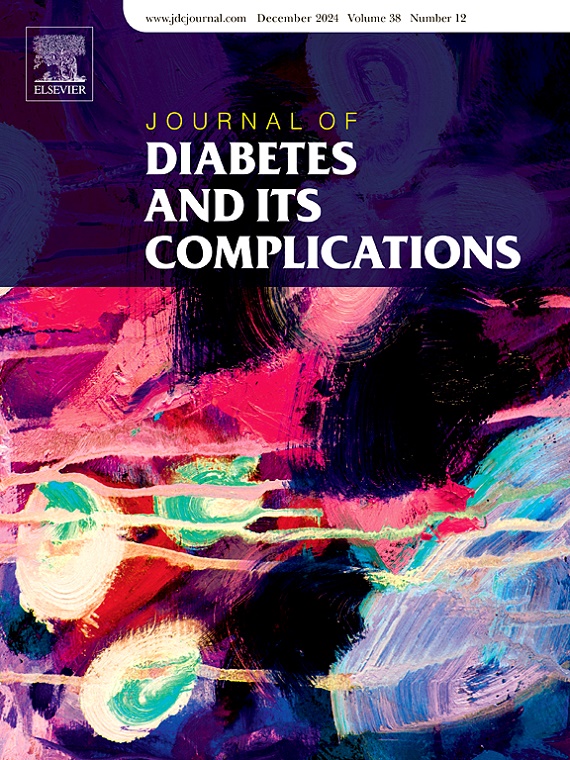The role of biomarkers of innate and adaptive immunity in the early detection of diabetic nephropathy in children and adolescents with type 1 diabetes mellitus
IF 3.1
3区 医学
Q3 ENDOCRINOLOGY & METABOLISM
引用次数: 0
Abstract
Aims
Neutrophil-to-lymphocyte ratio (NLR) and platelet-to-lymphocyte ratio (PLR) are biomarkers linked to microvascular complications in adult diabetics. This study aimed to assess whether NLR and PLR, which increase in chronic inflammation, could aid in early detection of diabetic nephropathy (DN) in children and adolescents with Type 1 diabetes mellitus (T1DM).
Methods
The study included 90 children and adolescents with T1DM and 30 healthy controls. Microalbuminuria, defined as urine albumin >20 μg/min, was used to indicate early DN. Participants were grouped by diabetes duration: 0–60 months, 61–120 months, and >120 months.
Results
NLR was significantly higher in patients with microalbuminuria compared to controls and those without microalbuminuria (p10 years. Positive correlations were observed between urinary albumin and NLR (r = 0.274, p = 0.003) and between PLR and diabetes duration (r = 0.286, p = 0.006). For early DN diagnosis, an NLR threshold of 1.675 showed 60 % specificity and 84.2 % sensitivity.
Conclusions
NLR outperformed PLR in early DN detection and may prompt timely urine albumin testing in children with T1DM. Further studies are needed to confirm these results.
先天免疫和适应性免疫生物标志物在儿童和青少年1型糖尿病肾病早期检测中的作用
目的:中性粒细胞与淋巴细胞比率(NLR)和血小板与淋巴细胞比率(PLR)是与成人糖尿病微血管并发症相关的生物标志物。本研究旨在评估NLR和PLR是否有助于1型糖尿病(T1DM)儿童和青少年糖尿病肾病(DN)的早期检测。NLR和PLR会增加慢性炎症。方法研究对象为90例T1DM儿童和青少年及30例健康对照。微量白蛋白尿,定义为尿白蛋白≤20 μg/min,用于早期DN的诊断。参与者按糖尿病病程分组:0-60个月、61-120个月和120个月。结果微量白蛋白尿患者的snlr显著高于对照组和无微量白蛋白尿患者(p < 0.05)。尿白蛋白与NLR呈正相关(r = 0.274, p = 0.003), PLR与糖尿病病程呈正相关(r = 0.286, p = 0.006)。对于早期DN诊断,NLR阈值为1.675,特异性为60%,敏感性为84.2%。结论snlr在早期诊断DN方面优于PLR,可提示T1DM患儿及时进行尿白蛋白检测。需要进一步的研究来证实这些结果。
本文章由计算机程序翻译,如有差异,请以英文原文为准。
求助全文
约1分钟内获得全文
求助全文
来源期刊

Journal of diabetes and its complications
医学-内分泌学与代谢
CiteScore
5.90
自引率
3.30%
发文量
153
审稿时长
16 days
期刊介绍:
Journal of Diabetes and Its Complications (JDC) is a journal for health care practitioners and researchers, that publishes original research about the pathogenesis, diagnosis and management of diabetes mellitus and its complications. JDC also publishes articles on physiological and molecular aspects of glucose homeostasis.
The primary purpose of JDC is to act as a source of information usable by diabetes practitioners and researchers to increase their knowledge about mechanisms of diabetes and complications development, and promote better management of people with diabetes who are at risk for those complications.
Manuscripts submitted to JDC can report any aspect of basic, translational or clinical research as well as epidemiology. Topics can range broadly from early prediabetes to late-stage complicated diabetes. Topics relevant to basic/translational reports include pancreatic islet dysfunction and insulin resistance, altered adipose tissue function in diabetes, altered neuronal control of glucose homeostasis and mechanisms of drug action. Topics relevant to diabetic complications include diabetic retinopathy, neuropathy and nephropathy; peripheral vascular disease and coronary heart disease; gastrointestinal disorders, renal failure and impotence; and hypertension and hyperlipidemia.
 求助内容:
求助内容: 应助结果提醒方式:
应助结果提醒方式:


